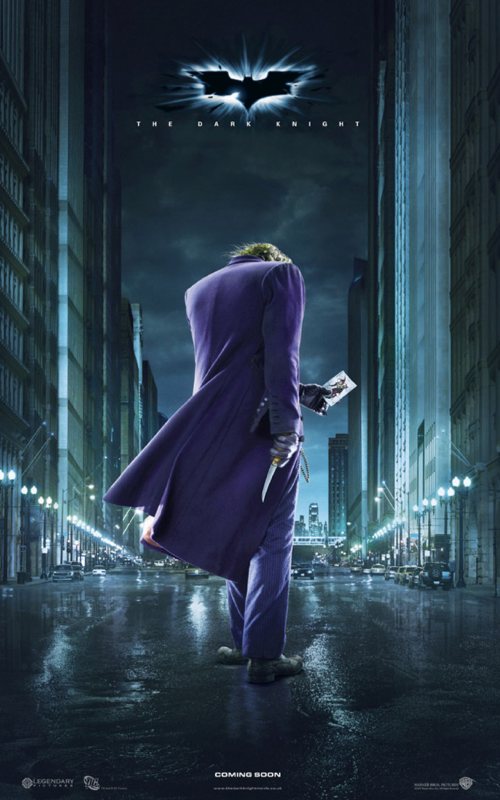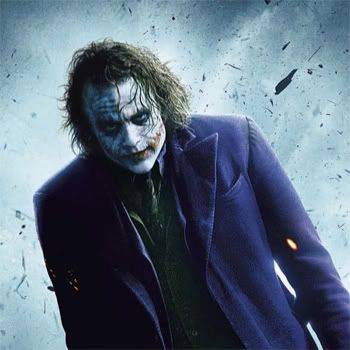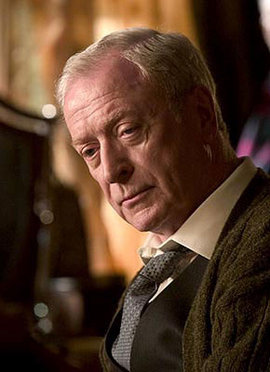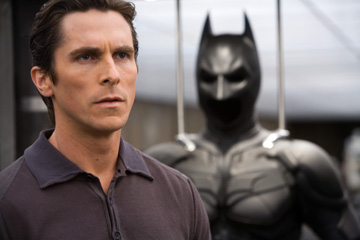
All of these momentous decisions are, of course, generated by the actions of the antagonist, the main instigator of conflict. Many articles, essays, reviews, and adulations have been written and rewritten towards gaining an analytical triangulation on the Joker’s character, and with good reason. I myself, perhaps in a later article, look to be writing a more in depth study about the Joker’s role in changing the landscape in cinematic superhero, and in some cases purely cinematic, history. For now, the Joker can be explained not only as an antagonist to Batman (the protagonist), but also as a representation of the thematic opposites that Batman chooses to crusade against. Though I would be the first to admit that the Joker in “The Dark Knight” is easily one of the most effective villains in recent cinematic memory, to say that he is the greatest cinematic villain of all time is premature, and to say that this representation of the Joker constitutes the greatest example of supervillainy of all time is just plain ludicrous and insulting. Again, more on that at a later date. Suffice it to say that the Joker’s most effective traits as it pertains to this movie is how he fulfills the function of a true villain, which constitutes the roles of both an antagonist (an instigator in the plot of the movie opposed to that of the protagonist) and an impact character (a symbol for themes representing “the wrong way to go,” also known in very rudimentary terms as a “bad guy”). The term villain has been quite overused in recent years and is thrown around with impunity without knowledge of its actual connotation. Now you can impress your friends: a “villain,” by definition, must be both an antagonist (plot function) and a bad guy (thematic function). A character can be just one of these and still not be a villain. Yet everyone, viewer and scholar alike, still seems to confuse and intermix these three terms. What is plain is that the Joker, in these contexts, represents one of the most effective examples of cinematic villainy.
It is plainly obvious what the Joker’s antagonistic role is in terms of plot development: his being given control of a great majority of organized crime in Gotham City leaves this subject pretty self-explanatory. Rather, it is the thematic opposition to the main character, Batman, that sets him apart from other plot-centric villains, such as Hans Gruber from “Die Hard” (or practically any other action movie hero). To explore these implications, one must first determine what the Joker’s stated purpose is to the dynamics of the theme. While it may be easy to label the Joker as “chaos,” this explanation is not quite adequate. The Joker represents many other things too: criminality first comes to mind, along with comparisons to predatory animals. These are good enough to express the Joker’s theme, but how to explain the Joker’s character dynamics? Fortunately, the Nolans made that connection much easier for the audience. Christopher and Johnathan Nolan are artistic film, character movie writers at heart, and as such can’t avoid slipping in self-aware proclamations from their main characters. Alfred pegged Joker’s character to a bullseye when he said that he just “wants to see the world burn.” That, stated, is his main motivation. His secondary motivations come from Joker’s own quotes about himself, when he claims that he is a “dog chasing cars” and a “mad dog.” It is the former proclamation that reveals how he goes about his work, in addition to the why. And ingeniously, this casual statement is a setup to the reason why Joker’s character is allowed to evolve and change throughout the movie, making him a much more potent villain.

Quentin Tarantino said famously in a Charlie Rose interview that he was disappointed that so many filmmakers have forgotten one of the main ingredients of a good story, namely, that it must evolve up until the very end. You should never know the ending of a movie after watching the first five minutes, as is the case with 98% of all movies nowadays (indeed, Tarantino’s movies always kept us guessing until the very end, from “Pulp Fiction” to “Kill Bill” to “Inglorious Basterds,” and this style was the norm for movies in Hollywood’s Golden Age). Because of this unfortunate trend, the movie’s villain becomes little more than an annoying, cloying obstacle that does little more than provide a sideshow distraction until the audience gets back to the plot. Hardly any villain in the last two decades, save most notably for Anthony Hopkins’s Hannibal Lecter, has been given the opportunity to evolve as the story evolves, becoming a true psychological terror. Joker’s “dog chasing cars” philosophy gives him the perfect excuse to morph between each act and develop into a true menace for Batman. Consider the unfolding of Joker’s character, which ironically begins at the end of the previous movie, “Batman Begins,” where he attempted to poison the city’s water supply. He since moved on to stealing money from the mob, just because. He then decides to join the mob to make even more money, then wants to unmask Batman, then wants to “give Gotham a better class of criminal,” and finally moves to destroy the moral fabric of Gotham and prove that the world is just as crazy as he is. He does this by turning Harvey Dent into Two-Face and it’s a wonderfully complex ladder that challenges Batman’s character, and the audience’s, every step of the way
Overall, “The Dark Knight” is a mindbending odyssey through what is sure to be a model for many summer action movies to come. While it’s not as revolutionary as, say, “Star Wars,” its nature suggest an evolutionary step in the presentation of action/adventure and superhero movies. It may not be absolutely perfect, but I will gladly pay $10 to see it again, and that’s all that the filmmakers need to aim for. Excelsior!
Concept: A-
Direction: A-
Acting: A-
Plot: B+
Theme: A+
Character Dynamics: A
Main Character: A-
Final Grade: A-



